I know what you’re thinking; “licenses? … don’t you keep telling us that licensed products suck”? Generally they do, and with the exception of Star Fleet Battles and Star Wars: The Queen’s Gambit and maybe a few others these licenses in particular have long histories of producing very under developed, mass market trash.
So what has changed? It’s the companies and designers behind these licenses. WizKids with Star Trek is going head to head against Fantasy Flight Games with Star Wars and the gaming public is likely to be the winner. Both companies are no strangers to turning licensed intellectual property into gold and what they’re promising now doesn’t disappoint. Let’s take a look
Star Trek: Fleet Captains
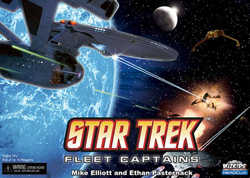 Wow, just wow. In one, admittedly expensive box Star Trek: Fleet Captains has managed to capture nearly every aspect of the Star Trek universe, at least as far as the Federation and Klingons are concerned (and we know expansions are coming). Explore the universe, conduct scientific and diplomatic missions, and when things don’t go your way, raise shields, power the weapons, and prepare to kick some Klingon ass. Oh yeah, that’s what I’m talking about, most of these ships may be Next Generation but this game has an old school Trek sensibility, the Prime Directive and Khitomer Accord peace treaties were just nuisances anyway.
Wow, just wow. In one, admittedly expensive box Star Trek: Fleet Captains has managed to capture nearly every aspect of the Star Trek universe, at least as far as the Federation and Klingons are concerned (and we know expansions are coming). Explore the universe, conduct scientific and diplomatic missions, and when things don’t go your way, raise shields, power the weapons, and prepare to kick some Klingon ass. Oh yeah, that’s what I’m talking about, most of these ships may be Next Generation but this game has an old school Trek sensibility, the Prime Directive and Khitomer Accord peace treaties were just nuisances anyway.

Star Trek: Fleet Captains contains 24 detailed ship models, evenly divided between the Federation and Klingon Empire. Each sculpt is unique and represents named or recognizable ships from the television and movie series including Enterprise A through E, Voyager, Defiant, and others (so yes, the game co-mingles multiple generations). The ships are mounted to HeroClix bases, an innovation developed by WizKids that simplifies play by tracking critical game information on a dial built into each base. Even unpainted these models are absolutely gorgeous.
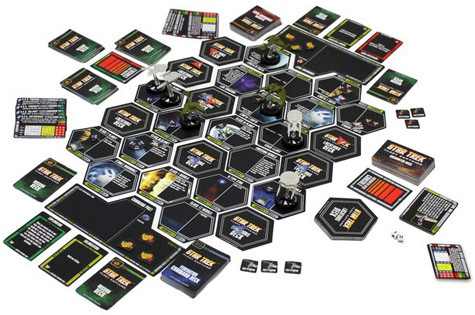
The board is an array of randomly drawn large hexagonal tiles initially placed face down. Players must explore the map, resolving encounter cards at each location and complete missions for victory points. The missions divide into science, influence, and combat, your ships in play will determine the mix of missions you must complete. Each player also builds a custom command deck from sets of cards representing crew members and personalities, each of which provides bonuses or special abilities. Properly matching the balance of cards in your command deck to mission requirements is one key to victory.
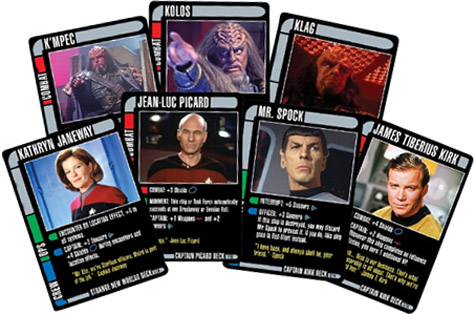
Star Trek: Fleet Captains was designed by Mike Elliot (Quarriors, Thunderstone) and published by WizKids. The game supports either two players, or 4 players divided into two teams. An expansion is in the works that will introduce a new faction (Romulans?) and will allow 3 players to compete head-to-head. A two player game can be completed in roughly 60 minutes. Star Trek: Fleet Captains is due in stores September 21, 2011 and can be pre-ordered from a variety of online sources. The list price is $100 although pre-order prices are running around $70.
Star Trek: Expeditions
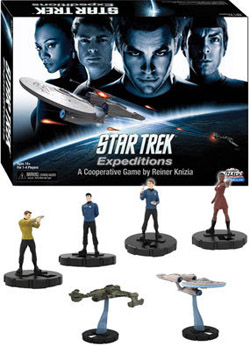 If you prefer your Trek slightly less confrontational and testosterone laden but no less challenging, Star Trek: Expeditions is worth a look. Star Trek: Expeditions was designed by acclaimed game designer Reiner Knizia (Lord of the Rings, Lord of the Rings: The Confrontation) and published by WizKids early in 2011. It is a cooperative game for 1 to 4 players that can be completed in about 1 hour. Star Trek: Expeditions is already available in stores and online for about $34.
If you prefer your Trek slightly less confrontational and testosterone laden but no less challenging, Star Trek: Expeditions is worth a look. Star Trek: Expeditions was designed by acclaimed game designer Reiner Knizia (Lord of the Rings, Lord of the Rings: The Confrontation) and published by WizKids early in 2011. It is a cooperative game for 1 to 4 players that can be completed in about 1 hour. Star Trek: Expeditions is already available in stores and online for about $34.
Star Trek: Expeditions is set entirely in the “new” Star Trek universe as depicted in the 2009 movie. Players assume the roles of Kirk, Spock, McCoy, or Ulhura, additional crew members will be available in expansions. The game includes a painted miniature for each crew member, as well as an Enterprise and Klingon ship maker. Each miniature is attached to a HeroClix style base as described above which tracks a crew member’s proficiencies in command, science, and operations, or systems status for the starships. Once again, these miniatures are absolutely gorgeous.
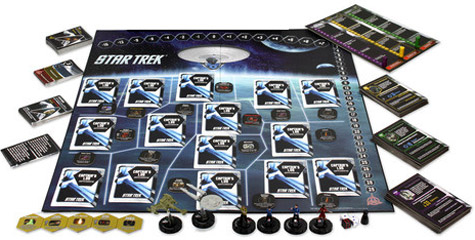
Where Fleet Captains attempts to capture the entirety of the Star Trek universe, Expeditions is much more character focused and has the feel of playing a single episode. Players find themselves on the troubled planet of Nibia. The planet is on the brink of civil war and facing an ecological disaster. The crew of the Enterprise must work together to resolve these issues and convince the government to join the United Federation of Planets in the process. Of course the Klingons aren’t going to sit idly by and watch this happen. A Klingon Battle Cruiser is in orbit, its crew disrupting events on the planet, and a full scale armada is en route giving the players limited time to accomplish their tasks.

Players have many options but exploring the planet’s surface and attempting to successfully resolve challenge cards are the most important. Success may advance a mission objective, improve a crew member’s skills, or provide clues, equipment, or allies that will be helpful on future challenges. Like many cooperative games, the first goal is not to lose. Star Trek: Expeditions can be lost either by allowing the Enterprise to be destroyed or by the arrival of the Klingon armada. Winning is graded on a scale depending on the crew’s performance in each of the three mission objectives.
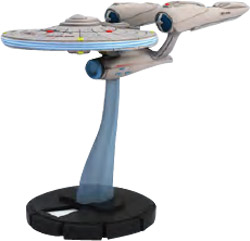 There is no dispute about the quality of game components in Star Trek: Expeditions; these are some of the best playing pieces you will ever find. Opinions on game play however are all over the map; from fanatical enthusiasm to mild disappointment. To start with, Star Trek: Expeditions is cooperative; a game style some people prefer while others find less than engaging. More problematic is the complaint that Star Trek: Expeditions can feel a little math heavy. Location challenges are really just target numbers that must be reached by combining a crew member’s proficiency with a long list of modifiers and finally a die roll; some players can look beyond the calculations and see the plot line unfolding, others find adding and subtracting chains of modifiers distracting and dry. While $34 is not a great risk, I would recommend trying this game before buying if the opportunity presents itself.
There is no dispute about the quality of game components in Star Trek: Expeditions; these are some of the best playing pieces you will ever find. Opinions on game play however are all over the map; from fanatical enthusiasm to mild disappointment. To start with, Star Trek: Expeditions is cooperative; a game style some people prefer while others find less than engaging. More problematic is the complaint that Star Trek: Expeditions can feel a little math heavy. Location challenges are really just target numbers that must be reached by combining a crew member’s proficiency with a long list of modifiers and finally a die roll; some players can look beyond the calculations and see the plot line unfolding, others find adding and subtracting chains of modifiers distracting and dry. While $34 is not a great risk, I would recommend trying this game before buying if the opportunity presents itself.
Star Wars: X-Wing

Not to be out done, Fantasy Flight Games has announced Star Wars: X-Wing designed by Jason Little (Blood Bowl: Team Manager The Card Game); an easy to play, tactical ship-to-ship combat game featuring classic Rebel X-Wings against Imperial TIE fighters. The game is scheduled for release “sometime in 2012” so details are sketchy at this point and subject to change, but this is what we know so far:
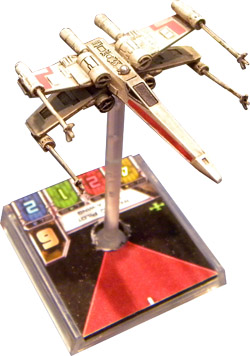 The base game will include 3 highly detailed painted miniatures, one X-Wing and two TIE fighters and will list for $40. Fighters can be customized through the selection of pilot and equipment cards including a choice of specialized droids for use in X-Wings. Individual ships with matching pilot and equipment cards will be sold separately for $10-$15 each.
The base game will include 3 highly detailed painted miniatures, one X-Wing and two TIE fighters and will list for $40. Fighters can be customized through the selection of pilot and equipment cards including a choice of specialized droids for use in X-Wings. Individual ships with matching pilot and equipment cards will be sold separately for $10-$15 each.
X-Wings and TIE fighters each have their own piloting dials used to secretly select speed and maneuver. Differences between these piloting dials reflect the differences in performance of each fighter, for example, the TIE fighter is much more maneuverable while the X-Wing can carry better equipment. Once speed and maneuver have been selected movement templates are used to reposition each ship. Hits are resolved through the draw of damage cards which may also inflict performance handicaps on the injured fighter. Readers familiar with the FFG World War I aerial combat game Wings of War will find some of this very familiar. Star Wars: X-Wing is very light and easy to play, two player games should last no more than 20 minutes.
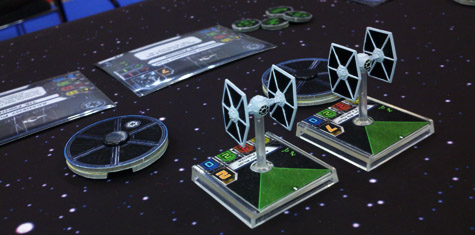
I hate pre-judging a game that isn’t in its final form but Fantasy Flight Games will be facing some tough competition from a similar game that is already on the market. Battleship Galaxies: The Saturn Offensive was released by Hasbro/Wizards of the Coast earlier this year. While it lacks a recognizable license Battleship Galaxies features 20 ships and slightly deeper game play at about the same price point. For FFG to succeed we’ll have to see how well they manage to integrate the Star Wars theme and make Star Wars: X-Wing more than a simple World War I combat game in outer space.
Star Wars: The Card Game
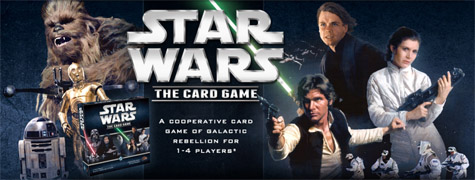
Fantasy Flight Games’ second Star Wars offering will be Star Wars: The Card Game designed by Nate French (The Lord of the Rings: The Card Game) and like Star Wars: X-Wing is also scheduled for release some time in 2012. This will not be the first time Star Wars has been rendered into a card game, however, in this incarnation Star Wars: The Card Game will be a cooperative game for 1 to 4 players and will be the fifth game to use FFG’s Living Card Game (LCG) format. I’ve written about the LCG format in a previous post; in brief the entire card mix is included in the core set, there is no blind buying or card randomization between sets. The core set will list for $40 and include two pre-constructed tournament decks; a second core set will be required to reach the maximum player count of four. Smaller Force Packs with a fixed card mix will be released on a regular basis to expand game play.
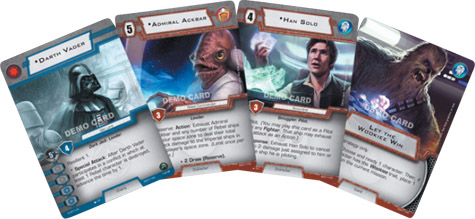
In Star Wars: The Card Game players work together as commanders of a Rebel strike force attempting to complete one of three available missions by paying for starships, recruiting heroes, and accumulating vital equipment and supplies . To succeed players must divide these resources between advancing the mission and defending the rebel base, they must also provide logistical support such as repairing ships and sorting through new intelligence.
 Players will find themselves opposed by the full might of the Empire. Star Wars: The Card Game uses an innovative custom strategy deck for each mission that dictates the play of Imperial cards and provides the game with a built in artificial intelligence.
Players will find themselves opposed by the full might of the Empire. Star Wars: The Card Game uses an innovative custom strategy deck for each mission that dictates the play of Imperial cards and provides the game with a built in artificial intelligence.
Publication of Star Wars: The Card Game is still a long way off but the reviews from demos have been generally positive. FFG has a lot of experience at making this type of game and each new title has been a refinement of the last.
Star Trek: The Deck Building Game

Do you still need more? I’m listing Star Trek: The Deck Building Game last because frankly, I don’t know much about it yet. This will be Alex Bykov’s first lead design credit and will be published by Bandai (Resident Evil: The Deck Building Game). The game will support 2 to 5 players, take roughly 45 minutes to complete, retail for about $40, and was scheduled for release in the summer of 2011 but that window is rapidly closing with no firm publication date in sight.

Like Resident Evil, this game will have 3 modes; Exploration mode will be a free for all, Borg Invasion will be cooperative, and Klingon Civil War will be team play. For those not familiar with the concept of a Deck Building Game you can read a four part post on the subject that starts here. Players will begin the game as captains of small Starships with basic crew and weaponry. By spending crew experience the crew cards, weaponry, and eventually starships can be upgraded. Players have the option to explore the Space Deck which contains a combination of events, missions, and enemy ships. Collecting mission cards is the key to victory, when a mission card is revealed it remains in play until one player can meet its objectives and win the card or until it is replaced by another mission. In exploration mode, the first player to collect 400 points worth of missions wins.
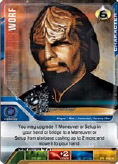 The rules are available online but at this time there is little or no feedback from demonstration games. One promising note, if the 45 minute playing time is to be believed, Bandai will have addressed the one major complaint gamers have with their otherwise excellent Resident Evil.
The rules are available online but at this time there is little or no feedback from demonstration games. One promising note, if the 45 minute playing time is to be believed, Bandai will have addressed the one major complaint gamers have with their otherwise excellent Resident Evil.
Important Photo Notes:
- The Federation Starships photo is courtesy of Nicole Wakelin, TotalFanGirl.com
- The X-Wing and TIE Fighter photos are courtesy of BoardGameGeek.com users Kevin Keefe and Paul Vogt respectively.
- The components shown for Star Wars: X-Wing and Star Wars: The Card Game are prototypes and do not reflect the expected finished quality.
When not violating the Prime Directive, Bob Gallo is a computer programmer specializing in Flash and interactive application design living in the Charlotte, NC area. Bob got his gaming start in the mid 1970s with traditional hex-and-counter war games and has played nearly all types of games including role playing games, miniatures, collectible card games, video/PC games as well as traditional board and card games.










